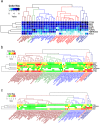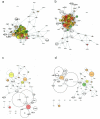An approach to cellular tropism of SARS-CoV-2 through protein-protein interaction and enrichment analysis
- PMID: 35672403
- PMCID: PMC9172986
- DOI: 10.1038/s41598-022-13625-z
An approach to cellular tropism of SARS-CoV-2 through protein-protein interaction and enrichment analysis
Abstract
COVID-19, caused by SARS-CoV-2, is a primarily pulmonary disease that can affect several organs, directly or indirectly. To date, there are many questions about the different pathological mechanisms. Here, we generate an approach to identify the cellular-level tropism of SARS-CoV-2 using human proteomics, virus-host interactions, and enrichment analysis. Through a network-based approach, the molecular context was visualized and analyzed. This procedure was also performed for SARS-CoV-1. We obtained proteomes and interactomes from 145 different cells corresponding to 57 different tissues. We discarded the cells without the proteins known for interacting with the virus, such as ACE2 or TMPRSS2. Of the remaining cells, a gradient of susceptibility to infection was observed. In addition, we identified proteins associated with the coagulation cascade that can be directly or indirectly affected by viral proteins. As a whole we identified 55 cells that could be potentially controlled by the virus, with different susceptibilities, mainly being pneumocytes, heart, kidney, liver, or small intestine cells. These results help to explain the molecular context and provide elements for possible treatments in the current situation. This strategy may be useful for other viruses, especially those with limited reported PPI, such as a new virus.
© 2022. The Author(s).
Conflict of interest statement
The authors declare no competing interests.
Figures







Similar articles
-
An improved Fuzzy based GWO algorithm for predicting the potential host receptor of COVID-19 infection.Comput Biol Med. 2022 Dec;151(Pt A):106050. doi: 10.1016/j.compbiomed.2022.106050. Epub 2022 Aug 25. Comput Biol Med. 2022. PMID: 36334362 Free PMC article.
-
SARS-CoV-2/human interactome reveals ACE2 locus crosstalk with the immune regulatory network in the host.Pathog Dis. 2021 Feb 19;79(2):ftab005. doi: 10.1093/femspd/ftab005. Pathog Dis. 2021. PMID: 33469663 Free PMC article.
-
SARS-CoV-2 pseudovirus infectivity and expression of viral entry-related factors ACE2, TMPRSS2, Kim-1, and NRP-1 in human cells from the respiratory, urinary, digestive, reproductive, and immune systems.J Med Virol. 2021 Dec;93(12):6671-6685. doi: 10.1002/jmv.27244. Epub 2021 Aug 4. J Med Virol. 2021. PMID: 34324210 Free PMC article.
-
Priming of SARS-CoV-2 S protein by several membrane-bound serine proteinases could explain enhanced viral infectivity and systemic COVID-19 infection.J Biol Chem. 2021 Jan-Jun;296:100135. doi: 10.1074/jbc.REV120.015980. Epub 2020 Dec 6. J Biol Chem. 2021. PMID: 33268377 Free PMC article. Review.
-
Network for network concept offers new insights into host- SARS-CoV-2 protein interactions and potential novel targets for developing antiviral drugs.Comput Biol Med. 2022 Jul;146:105575. doi: 10.1016/j.compbiomed.2022.105575. Epub 2022 Apr 30. Comput Biol Med. 2022. PMID: 35533462 Free PMC article. Review.
Cited by
-
SARS-CoV-2 cellular tropism and direct multiorgan failure in COVID-19 patients: Bioinformatic predictions, experimental observations, and open questions.Cell Biol Int. 2023 Feb;47(2):308-326. doi: 10.1002/cbin.11928. Epub 2022 Oct 13. Cell Biol Int. 2023. PMID: 36229927 Free PMC article. Review.
-
Protocol to identify host-viral protein interactions between coagulation-related proteins and their genetic variants with SARS-CoV-2 proteins.STAR Protoc. 2022 Aug 3;3(3):101648. doi: 10.1016/j.xpro.2022.101648. eCollection 2022 Sep 16. STAR Protoc. 2022. PMID: 36052345 Free PMC article.
-
Liver injury in COVID-19: an insight into pathobiology and roles of risk factors.Virol J. 2024 Mar 15;21(1):65. doi: 10.1186/s12985-024-02332-y. Virol J. 2024. PMID: 38491495 Free PMC article. Review.
-
Risk impact of SARS-CoV-2 coronavirus and spike protein on cardiac tissue: a comprehensive review.Physiol Res. 2024 Dec 31;73(S3):S655-S669. doi: 10.33549/physiolres.935476. Physiol Res. 2024. PMID: 39808169 Free PMC article. Review.
References
MeSH terms
Substances
LinkOut - more resources
Full Text Sources
Medical
Research Materials
Miscellaneous

